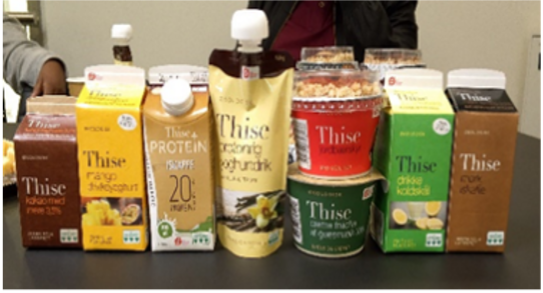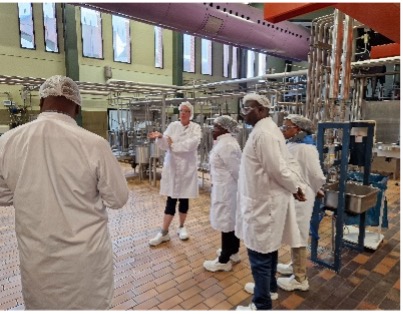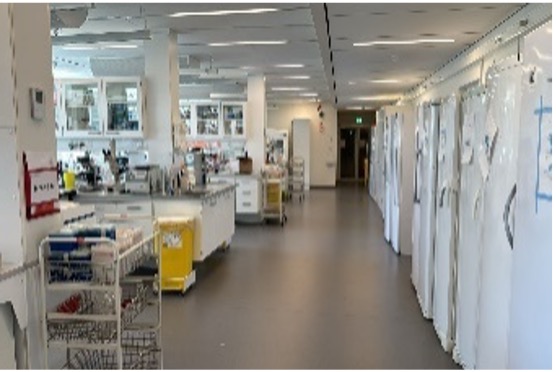
By Salma L.M.A Omollo
“A circular bioeconomy refers to converting renewable biological resources and valorising waste streams into value-added products, including food, feed, bio-based products, and bioenergy.”
Introduction
As part of the VALORISE project, our Kenyan team recently embarked on an enlightening 11-day research stay in Denmark. This memorable visit offered us invaluable insights into how Denmark has established itself as a global leader in the dairy industry, seamlessly integrating circular bio-economy principles into its sustainable growth strategy. With approximately 66% of Denmark’s land dedicated to agricultural and food production, the country has laid a robust foundation for its circular bio-economy.
Denmark’s government has crafted a comprehensive Circular Economy Strategy with specific targets, action plans, and key stakeholders, all aimed at transitioning to a circular economy by 2030. This strategy emphasizes sustainable production and consumption, resource efficiency, and waste reduction. Denmark’s success in fostering partnerships between research institutions, governmental authorities, and industry has been pivotal in developing responsible production and consumption solutions.
Our journey began in Jutland, the epicenter of Danish dairy farming and industry, and concluded in Copenhagen, where we witnessed the practical application of research and innovation. This blog highlights key moments from our visit and shares some valuable lessons we brought back.
Denmark Tour: A Journey Through Innovation and Sustainability
Our tour began with a visit to the picturesque Svinkløv Badehotel, nestled near Slettestrand in Jammerbugt Municipality, about 10 kilometers northeast of Fjerritslev. Built in 1925, this charming hotel is one of Denmark’s few entirely wooden hotels. After a devastating fire in 2016, it was meticulously rebuilt and reopened in 2019. Known for its stunning seaside location, traditional Danish architecture, and exquisite cuisine—particularly its famous walnut cake—the hotel operates from April to October and frequently hosts art exhibitions and classical concerts.
Continuing our journey through Jutland, we arrived in Aarhus, a vibrant city in Central Denmark renowned for its rich cultural tapestry and breathtaking landscapes. Aarhus University Foulum Research Centre, stands out for its pioneering research in sustainable farming, including precision agriculture, organic farming, and biogas production from organic waste. One particularly captivating project involves using automated robots to measure and analyze various crops and grasses emitting gases throughout the growing season. This innovative approach aims to mitigate greenhouse gas emissions, addressing critical climate change challenges.
Foulum Centre’s research also extends to livestock, where scientists introduce archaeal microorganisms into cow feed. This groundbreaking method alters the fermentation process within the cow’s digestive system, significantly reducing methane emissions in cow feces—a notable advancement in reducing agriculture’s environmental footprint.
Perhaps the most striking project is their agrivoltaic initiative, which ingeniously combines solar energy production with traditional farming practices. Solar panels, strategically placed to double as windbreakers and provide crop shade, illustrate a remarkable synergy between renewable energy and agriculture. This forward-thinking approach maximizes land use and exemplifies Denmark’s commitment to global sustainability. Aarhus University’s endeavors left a profound impression, showcasing how innovation and sustainability coexist harmoniously, paving the way for a greener, more efficient future.
In the suburb of Aarhus, we visited Arla Foods Ingredients (AFI), a central dairy cooperative that innovatively transforms whey, a cheese production byproduct, into valuable products. They produce high-quality protein powders for sports and medical nutrition, whey protein isolates, and concentrates to boost the food protein content and extract lactose for baby food and pharmaceuticals. Additionally, they enhance food texture and stability with whey proteins and extract health-promoting bioactive components. Their sustainable practices reduce waste and create new revenue streams, showcasing their commitment to sustainability and innovation in the dairy industry. AFI is a shining example of a company dedicated to sustainability in the food industry. The Centre hosts top scientists and facilitates world-class research and collaboration. For AFI, sustainability is not just a buzzword; it’s central to their vision, providing a reassuring outlook for the future of the food industry.
On our way to Thise Dairy, we visited one of Denmark’s pioneers in organic farming. The renowned organic farmer has a farm with 30 Jersey animals fed organically with pasture to produce organic milk. He practices farming in large fields and has greenhouses to train other farmers, offering knowledge and inspiration. We then proceeded to Thise Dairy, located in the small village of Thise in northern Denmark, approximately 20 kilometers north of Skive. Known for its commitment to organic quality and sustainable practices, Thise Mejeri exemplifies Denmark’s dedication to high-quality, sustainable food production. These organic dairy processes milk from different cattle breeds separately, creating various products from milk and yogurt to cheese and butter. Their dedication to quality and sustainability is truly commendable and worthy of support.
From Thise, our journey took us through the City of Skagen, Råbjerg Mile, and the tip of Denmark for some sightseeing. These spots in northern Denmark are renowned for their natural beauty and cultural significance. In Skagen, we admired the vibrant art scene and stunning landscapes. Råbjerg Mile, the largest migrating dune in Northern Europe, moves up to 18 meters yearly, offering a unique natural spectacle. At Grenen, the tip of Denmark, we witnessed the remarkable meeting point of the North Sea and the Baltic Sea, a geographical marvel.
After our sightseeing adventures, we visited Kold College in Odense. This institution boasts the largest training dairy for students, a well-equipped lab, advanced greenhouse demonstration farms, a small zoo, and practical landscaping fields. Kold College, offering vocational programs in food and agriculture, plays a pivotal role in Denmark’s circular bio-economy. The college’s focus on community and professionalism prepares students for gastronomy, horticulture, and zookeeping careers, contributing significantly to the country’s sustainable future. We met the NGO Dairy Without Borders director there and initiated more research collaborations and potential partnerships for future project engagements.
The tour culminated in Kongens Lyngby, about 12 kilometers north of central Copenhagen, at the Technical University of Denmark (DTU)—National Food Institute. DTU is critical in supporting EU bio-economy strategies and conducting pioneering research on bio-based technologies and sustainable solutions. DTU’s collaborations with Nordic universities to promote circular economy education and extend the lifespan of resources are inspiring examples of the potential for sustainability, inviting global participation and collaboration.
Our tour then proceeded to Revos Innovation Centre, where we visited Lactolink (startup), a collaboration between SEGES Innovation and R2 Agro A/S. This initiative utilizes dairy permeate to produce yeast biomass for piglet feed, enhancing resource efficiency and reducing antibiotic use.
We then visited Roskilde University, Department of People and Technology, and Copenhagen University, Department of Food Science and Technology in Copenhagen. We discussed potential research collaborations and postgraduate supervision at Roskilde University. These institutions are paving the way for a more sustainable future, and their efforts should be a source of hope and encouragement for all those interested in the circular economy.
Strategic Vision


Denmark’s Circular Economy Strategy, targeting full circularity by 2030, emphasizes sustainable production, resource efficiency, and waste reduction through solid partnerships among research institutions, government, and industry. These collaborations drive innovation, knowledge sharing, and sustainable solutions, exemplifying Denmark’s success in circular bio-economy initiatives.

Remarkable Achievements
Denmark excels in resource efficiency with an 88% recycling rate for food waste, significant biogas plant investments, and advanced sustainable agriculture through precision farming. Companies like Arla Foods Ingredients and Thise Mejeri champion circular economy principles, while public policies, educational programs, and ambitious carbon neutrality goals underscore Denmark’s commitment to sustainability and emission reduction.
Conclusion
Denmark’s transition to a circular economy, driven by agriculture replacing fossil fuels with renewable resources, reduces environmental pressure and carbon emissions while fostering new business models, technologies, and job creation. This transformation enhances exports and economic growth, turning waste into valuable resources and showcasing a sustainable future.
Salma L.M.A Omollo
Author and Graduate Research Assistant, VALORISE Project
